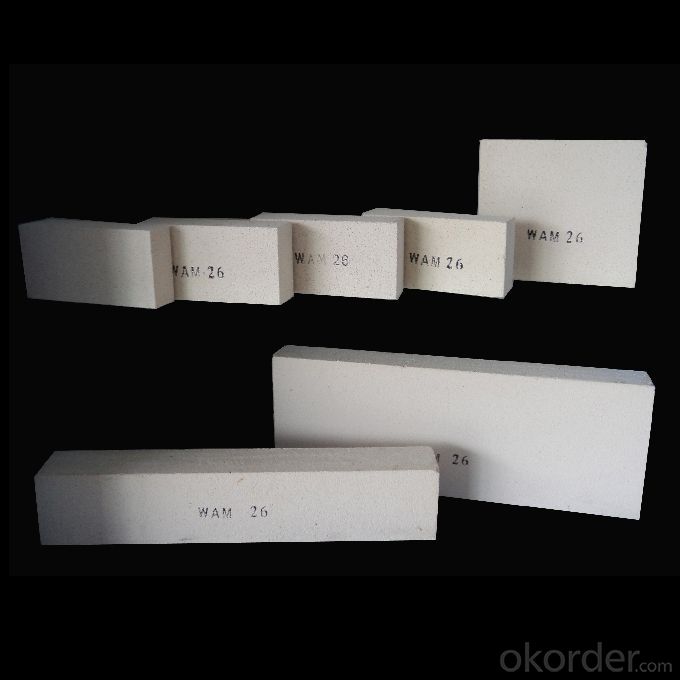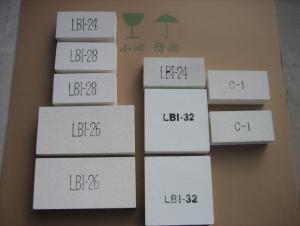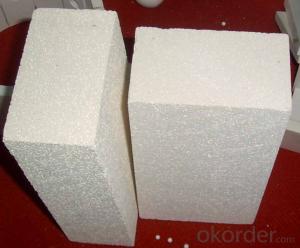Refractory Mullite Insulating Refractory Brick JM 24
- Loading Port:
- Shanghai
- Payment Terms:
- TT OR LC
- Min Order Qty:
- 20 m.t.
- Supply Capability:
- 20 m.t./month
OKorder Service Pledge
OKorder Financial Service
You Might Also Like
Okorder series heat insulation brick
Okorder series thermal insulation brick is an effective, energy saving, low carbon, environmental protection advanced, according to the ASTM standard manufacturing products. Okorder series products have all kinds of materials in the field of metallurgy, industrial furnaces, aluminum, the best Li Ning petrochemical and insulation, electric power and glass ceramics. They can be used as part of an insulation or not to melt. Products have been widely used in the following furnace, achieved satisfactory results.
Application of heat preservation brick
Metallurgical Industry: blast furnace, hot blast furnace, heating furnace, etc..
Petrochemical Industry: ethylene cracking furnace, hydrogen furnace, the main furnace, heating furnace, etc..
Ceramic industry: roller kiln, kiln, etc..
Glass industry: glass furnace regenerator, etc.
Carbon industry: carbon furnace, etc..
Aluminum electrolysis industry: aluminum reduction cell, etc.
Other industries: tunnel kiln, shuttle kiln, etc..
Advantages of heat insulation brick
Low thermal conductivity: many air holes will bring good thermal insulation effect, energy saving.
High crushing strength: high crushing strength, volume stability.
Low heat storage: small heat storage, absorb more heat, energy-saving effect is obvious.
Chundu: High-speed Rail, low content of alkali metal impurities.
Accuracy: the size of the brick machining precision, cutting and grinding the special shape, speed up the brick.
Technical Data
ITEM | GJM30 | GJM28 | GJM26 | GJM23 |
Classification Temperature, ℉/℃ | 3000/1650 | 2800/1540 | 2600/1430 | 2300/1260 |
Bulk Density,g/cm³ | ≤1.0 | ≤0.9 | ≤0.8 | ≥0.5 |
Reheating Linear Change, % | ≤0.9 (1550℃,12 h) | ≤0.8 (1510℃,12 h) | ≤0.7 (1410℃,12 h) | ≤0.5 (1230℃,12 h) |
Al2O3 Content, % | ≥75 | ≥65 | ≥55 | ≥45 |
Fe2O3 Content, % | ≤0.5 | ≤0.6 | ≤0.7 | ≤1.0 |
Thermal Conductivity: | ||||
800℃, w/m.k | ≤0.39 | ≤0.37 | ≤0.35 | ≤0.18 |
1000℃, w/m.k | ≤0.43 | ≤0.41 | ≤0.39 | ≤0.20 |
1200℃, w/m.k | ≤0.48 | ≤0.46 | ≤0.43 | --- |
Insulating brick

- Q:Can insulating fire bricks be used in lime plants?
- Yes, insulating fire bricks can be used in lime plants. They are commonly used in high-temperature applications, such as lime kilns, to provide thermal insulation and reduce heat loss. Insulating fire bricks help maintain consistent and efficient heat distribution, which is essential for the lime production process.
- Q:Can insulating fire bricks be used in solar power plants?
- Insulating fire bricks have the ability to be utilized in solar power plants. These bricks are specifically designed to possess exceptional thermal insulation properties, thus making them suitable for various applications that demand resistance to heat and energy efficiency. Solar power plants frequently experience high temperatures and the necessity to retain heat, particularly in concentrated solar power (CSP) systems. By using insulating fire bricks to line the walls and floors of CSP receivers and thermal storage systems, the loss of heat can be minimized and the conversion of solar energy into electricity can be maximized. Furthermore, insulating fire bricks can also find utility in other components of solar power plants, such as the insulation of solar panels or the construction of solar tower structures.
- Q:Can insulating fire bricks be used in chimneys or flues?
- It is not advisable to use insulating fire bricks directly in chimneys or flues due to their primary purpose of insulation rather than being a structural component. Chimneys and flues require refractory bricks that are specifically engineered to withstand the intense heat and corrosive byproducts of combustion. These refractory bricks have high thermal resistance and exceptional durability, ensuring the safe and efficient operation of the chimney or flue. Therefore, it is recommended to use refractory bricks instead of insulating fire bricks for construction or repair purposes in chimneys and flues.
- Q:How do insulating fire bricks affect the overall efficiency of a heating system?
- Insulating fire bricks play a crucial role in enhancing the overall efficiency of a heating system. These bricks are specifically designed to have low thermal conductivity, meaning they are excellent at trapping and retaining heat within the system. By using insulating fire bricks, the heat loss from the heating system is significantly reduced, resulting in improved energy efficiency. One of the key benefits of insulating fire bricks is their ability to minimize heat transfer through conduction. These bricks have a high resistance to heat flow, which means they act as a barrier, preventing the heat from escaping the system. This is especially important in areas where high temperatures are generated, such as furnaces or kilns. By containing the heat within the system, insulating fire bricks enable the heating system to maintain a consistent temperature, reducing the need for excessive energy consumption to compensate for heat loss. Furthermore, insulating fire bricks also help decrease heat loss through radiation. These bricks have a high emissivity, which means they radiate less heat than other materials. As a result, the heat produced by the system is focused on the desired area, rather than being wasted through radiation. This not only improves the efficiency of the heating system but also ensures that the heat is effectively utilized for the intended purpose. Another advantage of insulating fire bricks is their ability to withstand high temperatures without deteriorating. Due to their composition and manufacturing process, these bricks can handle extreme heat levels, maintaining their structural integrity over time. This durability is important for the longevity of the heating system and ensures that the insulating properties of the bricks remain intact. In summary, insulating fire bricks have a significant positive impact on the overall efficiency of a heating system. Their low thermal conductivity, ability to minimize heat transfer through conduction and radiation, and durability at high temperatures all contribute to reducing heat loss and improving energy efficiency. By incorporating insulating fire bricks into a heating system, users can enjoy a more efficient and cost-effective heating solution.
- Q:Do insulating fire bricks require a refractory mortar for installation?
- Yes, insulating fire bricks typically require a refractory mortar for proper installation. Insulating fire bricks are lightweight and have high insulating properties, making them ideal for applications where thermal efficiency is important. However, due to their lightweight nature, they can be more fragile and prone to cracking or breaking under stress. Using a refractory mortar specifically designed for high-temperature applications helps ensure a strong and durable bond between the bricks. Refractory mortars are formulated to withstand high temperatures and provide excellent adhesion and thermal expansion properties. This mortar helps to create a solid and secure structure by filling in gaps between the bricks and providing additional support. Without the use of refractory mortar, insulating fire bricks may not be properly secured and could shift or separate over time, compromising the integrity of the installation. Additionally, the absence of refractory mortar may result in reduced thermal efficiency due to increased heat loss through gaps and spaces between the bricks. Therefore, it is highly recommended to use a refractory mortar when installing insulating fire bricks to ensure a strong and long-lasting construction.
- Q:Can insulating fire bricks be used in rocket stoves?
- Yes, insulating fire bricks can be used in rocket stoves. In fact, they are often preferred for their high insulation properties. Insulating fire bricks are made from lightweight refractory materials, such as silica, which have low thermal conductivity. This means that they are able to withstand high temperatures while minimizing heat loss, making them an ideal choice for rocket stoves. Rocket stoves are designed to efficiently burn biomass fuel, such as wood or charcoal, by creating a combustion chamber with a vertical chimney. The insulating fire bricks can be used to construct the combustion chamber and line the chimney, ensuring that the heat generated by the fire is effectively contained and directed towards the cooking surface. By using insulating fire bricks, rocket stoves can achieve higher temperatures and maintain them for longer periods of time. This results in more efficient and effective cooking, as well as reduced fuel consumption. Additionally, the insulating properties of these bricks also help to protect the surrounding environment from excessive heat, reducing the risk of accidental burns or fires. Overall, insulating fire bricks are a suitable choice for rocket stoves due to their ability to withstand high temperatures, minimize heat loss, and improve the efficiency of the cooking process.
- Q:Can insulating fire bricks be used in the construction of refractory linings?
- Yes, insulating fire bricks can be used in the construction of refractory linings. Insulating fire bricks have excellent thermal insulation properties, low thermal conductivity, and high refractoriness, making them suitable for applications where heat retention and energy efficiency are important. They are commonly used in industries such as steel, ceramics, glass, and cement to line kilns, furnaces, and other high-temperature equipment.
- Q:Can insulating fire bricks be used for chimney lining?
- Yes, insulating fire bricks can be used for chimney lining. Insulating fire bricks are designed to withstand high temperatures and are excellent for insulating chimneys, providing thermal protection and enhancing energy efficiency.
- Q:Are insulating fire bricks suitable for insulation in boilers for steam generation?
- Yes, insulating fire bricks are suitable for insulation in boilers for steam generation. Insulating fire bricks are specifically designed to have excellent thermal insulation properties, which make them ideal for use in high-temperature applications such as boilers. These bricks have a low thermal conductivity, meaning they can effectively reduce heat transfer and prevent heat loss. This insulation capability helps to maintain high temperatures within the boiler, improving energy efficiency and reducing fuel consumption. Additionally, insulating fire bricks are resistant to thermal shock, which is crucial for withstanding the extreme temperature fluctuations that occur in steam generation. Overall, using insulating fire bricks in boilers for steam generation can enhance the thermal efficiency and performance of the system.
- Q:How long do insulating fire bricks typically last?
- IFBs, also known as insulating fire bricks, have the potential to endure for multiple years depending on various factors such as brick quality, exposure conditions, and maintenance level. Generally, well-manufactured IFBs can last for 10 to 20 years or potentially longer with appropriate care. The duration of IFBs is influenced by the temperature to which they are exposed. These bricks are engineered to withstand high temperatures, typically ranging from 2,000 to 3,200 degrees Fahrenheit (1,093 to 1,760 degrees Celsius). However, prolonged and extreme exposure to such high temperatures can gradually degrade and weaken the bricks, reducing their lifespan. The lifespan of insulating fire bricks can also be affected by thermal cycling, chemical exposure, and mechanical stress. Repeated heating and cooling cycles can cause expansion and contraction, leading to cracks and eventual failure. Furthermore, chemicals present in specific applications, such as acids or alkalis, can corrode the bricks over time. Additionally, excessive pressure or impact can result in the bricks breaking or chipping, thereby diminishing their effectiveness. To significantly extend the lifespan of IFBs, proper maintenance and care are necessary. Regular inspections should be carried out to identify any indications of wear, damage, or deterioration. Prompt replacement of cracked or damaged bricks is essential to prevent further issues. Additionally, regular cleaning of the bricks is crucial to eliminate any accumulated debris or residues that could potentially compromise their insulating properties. Ultimately, the lifespan of insulating fire bricks varies depending on multiple factors and can differ across various applications. Nonetheless, with careful selection, proper installation, and regular maintenance, IFBs can provide reliable insulation and longevity for many years.
1. Manufacturer Overview |
|
|---|---|
| Location | |
| Year Established | |
| Annual Output Value | |
| Main Markets | |
| Company Certifications | |
2. Manufacturer Certificates |
|
|---|---|
| a) Certification Name | |
| Range | |
| Reference | |
| Validity Period | |
3. Manufacturer Capability |
|
|---|---|
| a)Trade Capacity | |
| Nearest Port | |
| Export Percentage | |
| No.of Employees in Trade Department | |
| Language Spoken: | |
| b)Factory Information | |
| Factory Size: | |
| No. of Production Lines | |
| Contract Manufacturing | |
| Product Price Range | |
Send your message to us
Refractory Mullite Insulating Refractory Brick JM 24
- Loading Port:
- Shanghai
- Payment Terms:
- TT OR LC
- Min Order Qty:
- 20 m.t.
- Supply Capability:
- 20 m.t./month
OKorder Service Pledge
OKorder Financial Service
Similar products
New products
Hot products
Related keywords




























